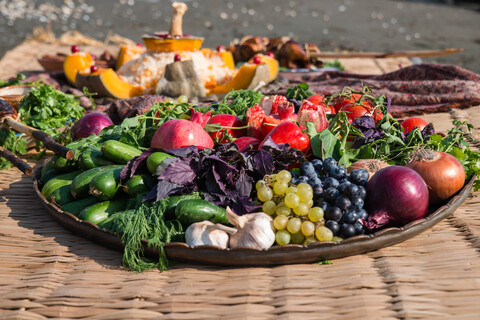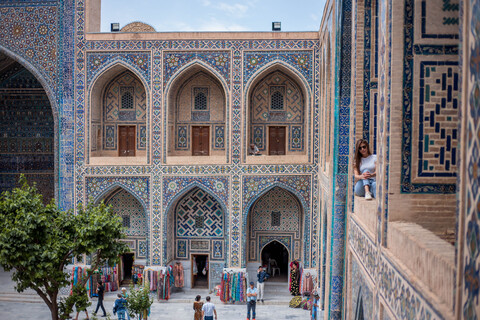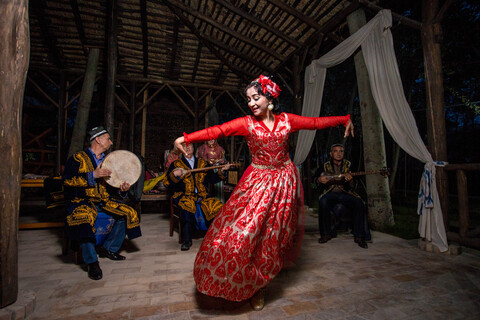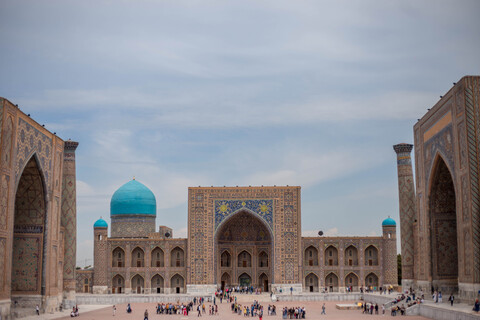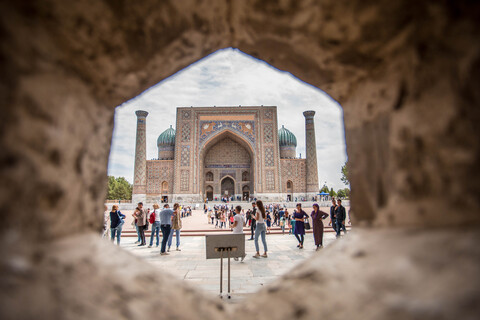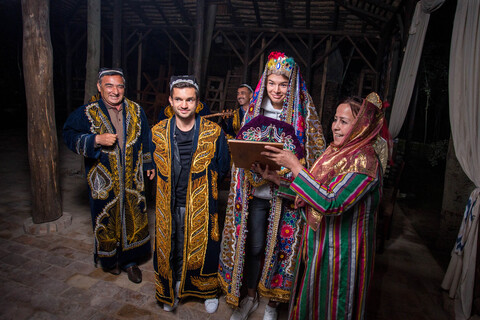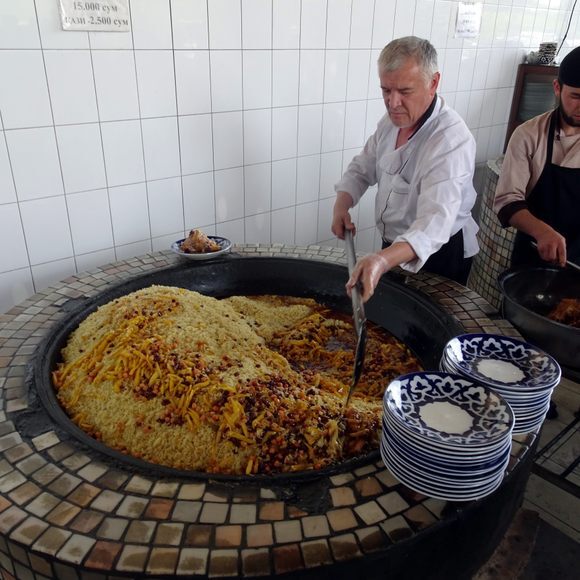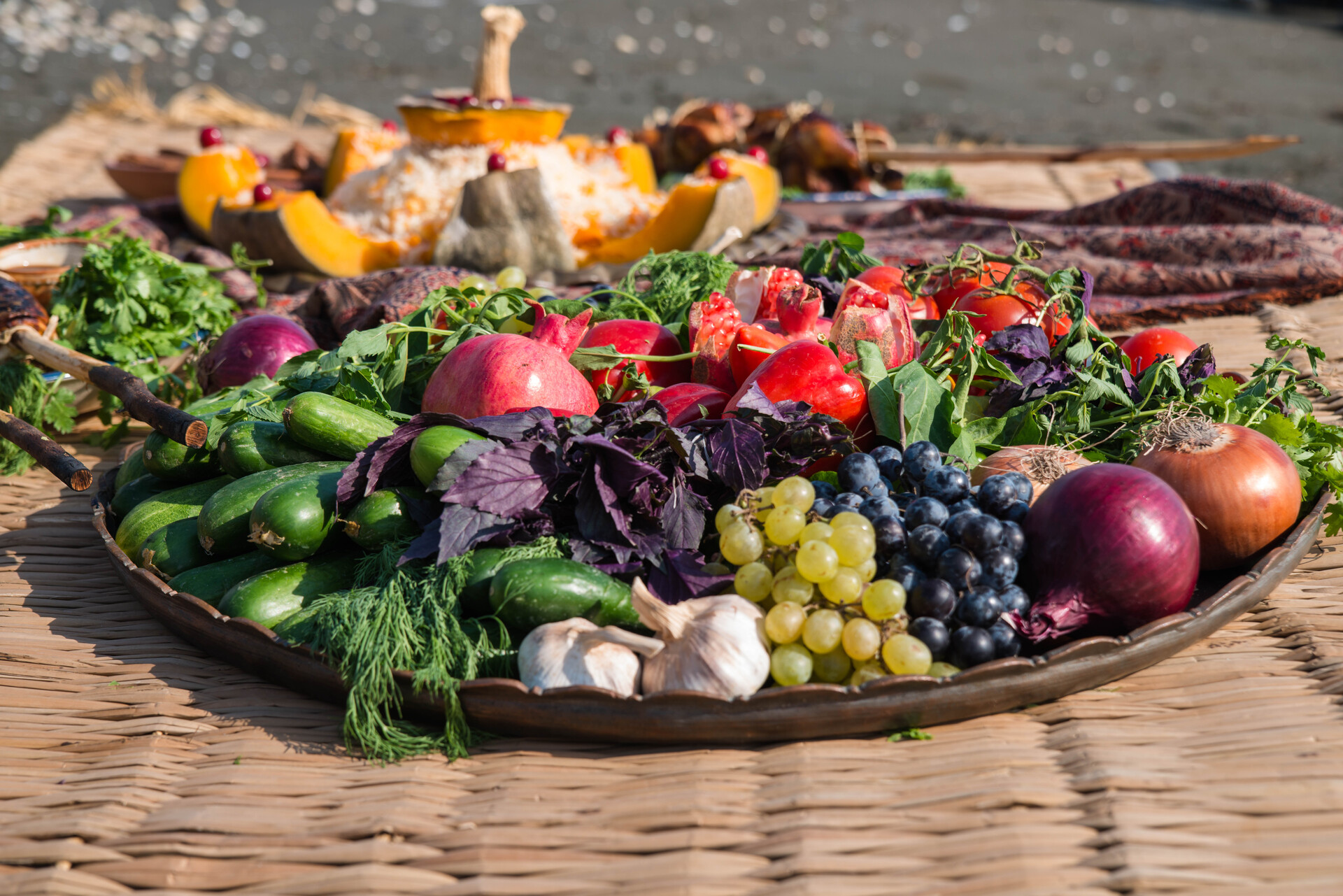
Uzbekistan
Gourmet tours - Uzbekistan
0 EUR
Uzbekistan for gourmets
As often happens, the hallmark of a kitchen is just a few dishes. But what! Pilaf, manti, samsa, shurpa, chuchvara, lagman...
Uzbek cuisine includes more than a hundred pilaf recipes, dozens of types of kebabs and meat dishes, rich soups, exotic salads, delicious oriental sweets, various flatbreads and flour products. These are long meals with endless bowls of tea and unhurried conversations.
The tour we offer will reveal to you the wonderful world of Uzbek cuisine, like a fairy tale of 1001 nights, full of its oriental secrets. Without knowing these secrets, you will not be able to taste real Uzbek pilaf, kebab, lagman and other original dishes.
In Uzbekistan, there is a saying that guests can leave the house only after they have tasted the pilaf prepared by the owners. Pilaf or, as it is called in Uzbekistan – palov, is a traditional dish that every resident of Uzbekistan should be able to prepare. This delicious food is made from very simple ingredients: rice, meat, spices, carrots and onions. Pilaf is served as an everyday and holiday dish, especially for such events as a wedding, return from a pilgrimage, birth of a child, anniversary, funeral, and as an aid to those in need. The history of pilaf goes back to the ancient times.
It is believed that a guest who has visited Uzbekistan and has not tasted real Uzbek pilaf, did not know the essence of Uzbek culture and hospitality. Uzbek pilaf is a dish of true gourmets and connoisseurs of Oriental cuisine. There are more than 100 pilaf recipes in the world, and Uzbekistan boasts of its own branded versions.
In each region of Uzbekistan pilaf is prepared according to the unique recipes. For example, in Tashkent holiday pilaf “Bayram Osh” is prepared, in Andijan the rolls from grape leaves are added to pilaf(“Kovatok palov”), in Khiva dietetic version of pilaf is cooked (“Chalov”).
However, few people know about the history of pilaf. An ancient legend tells about the origin of the word “palov”, which is associated with the name of the great Avicenna. In fact, palov is an abbreviation consisting of the capital letters of the dish's ingredients: P-piyoz-onion, A-AEZ-carrot, L-lahm – meat, O-olio – oil, V-vet – salt.
Once, the son of Bukhara ruler met a beautiful girl from a poor family. Because of class inequality, their marriage was impossible. Suffering from an unhappy love, the Prince weakened and lost interest in life and food. Then his father invites the famous physician Abu Ali Ibn Sino (Avicenna). He asked to find out the cause of this disease and cure the young heir. After examination, Ibn Sino realized that the cause of the young man’s illness was unhappy love. Ibn Sino told the ruler that there are 2 options to bring his son back to life: the first option is to marry the young man to his loved girl; the second option is to feed him one very high – calorie drug of seven ingredients called “palov”. After feeding the Prince this dish, Avicenna saw that his patient felt an unexpected surge of strength. Since that time the palov became widely used by the people and turned from the medicinal drug into a regular dish during the wide feasts and celebrations.
An old Eastern proverb says: “A good pilaf needs a hot fire, a cauldron with rice and meat, and ... love”. Indeed, there are some subtleties in the preparation of pilaf. For example, the meat should be washed only in running water, and the rice should be carefully sorted, lightly rubbing it between the palms. The oil is poured into the cauldron after it is properly heated, then the fire is reduced and meat, onions, carrots and spices are put into the cauldron – it turns out “Zirvak”. When “Zirvak” is ready, rice is poured into the cauldron. The pilaf is very tasty on the open fire.
In Uzbekistan pilaf has been an indispensable part of the ritual of family celebrations for a long time. Indeed, pilaf unites people, strengthens relationships, gives life, and supports health and immunity – it must be a reason why Avicenna has recommended it.
The culture and tradition of pilaf cooking was included into the list of UNESCO's Intangible Cultural Heritage in 2016.
Day 1 Air flight to Bukhara
Arrival in Bukhara.
The necropolis of Bahauddin Nakshbandi (10 km from Bukhara) is the burial place of the Sufi mystic of the Nakshbandi order Bahauddin Nakshbandi, a saint revered throughout the Muslim world. It is known that Nakshbandi was Temur's spiritual mentor and performed the Hajj to Mecca 32 times. He urged people to be modest, rejected luxury. His philosophy was based on the principle: "Dil ba eru das bokur" ("God is in the heart, and work is in the hands").
The Chor-Bakr necropolis (10-16 centuries) is the “city of shadows”, which once served as a family residence for the spiritual leaders of the Naqshbandi order (4 km from Bukhara). The first burials appeared here a thousand years ago, when there was a small settlement of dervishes nearby. But the magnificent architectural ensemble, which is now visited by thousands of pilgrims and tourists, was built only in the 16th century. Chor-Bakr is really an unusual, mysterious place. When visiting Chor-Bakr, it is impossible not to feel the breath of the world of the dead, where in the silence of the alleys one involuntarily visits thoughts about the frailty of being and the transience of human life.
Lunch at the tea house.
Sitora-i-Mohi Khosa (4 km from Bukhara) is the summer palace of the last Emir of Bukhara (19th century). The best Bukhara masters of that time, as well as two Russian engineers Margulis and Sakovich, took part in the construction. The residence of the last emir of Bukhara, where today, like a hundred years ago, peacocks strut importantly, appears before the visitors in the reflections of its former splendor, as if still ready to receive royalty and overseas ambassadors.
Tea drinking in the traditional Bukhara tea house "Spice House" - here guests can get a brief essay on Uzbek spices.
The Tea House "Spices of the Silk Road" was opened under the management of Mirfayoz Ubaydov, a famous supplier of spices from Bukhara.
Visit this unique cafe that will surprise you with a huge variety of delicious teas made from herbs and spices.
Day 2. Bukhara
Fortress of the ARC (IV BC - XIX century) - in the Middle Ages it was a whole city with the emir's palace, a mint, mosques, government institutions, warehouses, shops, a prison and an area for public meetings;
The Mausoleum of the Samanids (IX - X c) - the first building in Central Asia, built of baked brick in the shape of a cube, with a covered dome and a unique geometric design of masonry - a masterpiece of world architecture.
A visit to the oriental bazaar and the purchase of products for the preparation of lagman (the purchase will be made by the tourists themselves with the help of a guide, while the money for the purchase will be allocated to them. Guests will need to show skill and oriental bargaining skills in order to properly distribute the money allocated to them).
Lagman master class at the National House. The guests will be directly involved in the preparation of the lagman and will even roll out the dough themselves. The action will take place in a typical Uzbek house. After preparing the lagman, the guests take their places at the table and try their culinary creation.
Visiting the old Bukhara baths (XVI century). Body cleansing procedures according to old recipes are still used here (for additional payment).
Day 3. Bukhara
Walking sightseeing tour of Bukhara:
Lyabi-Khauz complex (XVI-XVII centuries) - a complex consisting of a mosque, Nodir Devon-Begi madrasah and a caravanserai. In the middle of the complex is a large pond surrounded by old trees.
The Poikalyan complex (XII - XVI centuries) - an architectural ensemble in the center of old Bukhara - includes the mosque of the cathedral "Majidi Kalyan", "Miri Arab" madrasah and the highest minaret (46 m) in the Central Asian region - Minori Kalyan.
Tim Abdullakhan was built in 1577 and was one of the most elegant trading halls in Bukhara, where silk and wool imported from Afghanistan were sold.
Trading Domes consist of three shopping centers: Toki Zargaron (1570) - a jewelers' bazaar, Toki Telpak Furushon - a skullcap bazaar, Toki Sarrafon - a money changer's bazaar. Here you can buy many wonderful souvenirs and find real rarities.
Lunch at Faizulla Khodjaev's house. The museum, a magnificent example of Bukhara architecture of the late 19th century, is housed in the house of F. Khodzhaev's father, Ubaydulla Khodja, in the old quarter of Gozien. In the restored rooms, the old decorations, interiors of living rooms, clothes, dishes and other household items of the late 19th - early 20th centuries have been restored.
Dinner with a folklore performance and a show of Uzbek national costumes at the Nodir Divon-Begi madrasah (dress is free).
At present, this famous madrasah has become a place of attraction for tourists and guests of the city of Bukhara. It attracts tourists not only with its original architecture and interesting history of creation, but also with national performances that are held in the open air. The madrasah has created a unique opportunity to join the cultural heritage of the Uzbek people in its entirety, including national classical music, dances, cuisine and much more. Once here, you are immersed in the special atmosphere of carefully preserved national traditions.
Day 4. Bukhara – Samarkand
Breakfast.
Departure to Samarkand (300 KM - 4 HOURS, BUS WITH AIR CONDITIONING), upon arrival accommodation at the hotel. Relaxation.
Lunch at the Karimbek restaurant.
Here they offer lagman and more than 15 varieties of shish kebab. And, the fabulous taste of fresh vegetables and fruits will be remembered for a long time. The restaurant is an old oriental house with a traditional open gallery-aiwan, the interior decoration used: national ceramics, handmade fabrics and embroidery, natural wood and juicy folklore motifs.
We go on a bus tour of Samarkand.
Registan Square (XV-XVII centuries) is a unique ensemble consisting of three madrasas, which were and are the center of the old city. The pearl of Samarkand.
Mausoleum Gur Emir (XV century) - the burial place of the Timurid dynasty. A unique architectural monument with an unforgettable blue dome. As the heralds of those times used to say; "People! If the sky falls to earth, the dome of Gur Emir will replace it!”
Tasting of collection wines at the winery. Khovrenko.
After the traditional historical essay about the oldest winery in the city, guests will be offered 10 traditional glasses "in ascending order": from wine to balm - all the best that sunny Uzbekistan is famous for.
Day 5. Samarkand
Breakfast.
Departure to the mountains for a picnic by car. Active games (football, volleyball, donkey riding). Those who wish to take part in the preparation of food. All day full rest in nature.
Shurpa preparation.
The situation with soups is also very interesting in Uzbek cuisine. First, there are a lot of them. Secondly, they are usually boiled with a lot of meat, vegetables, cereals and legumes. The spoon is in them. They say this is because the nomadic ancestors had to desperately save water. That is, it turns out, the soup is thick from need. Yes, the East is a delicate matter!
Early Dinner: Kebabs in the Amankutan Mountains!!!! Shashlik (pork, lamb, beef) is prepared by the chef.
Day 6. Samarkand
We go on a bus tour of Samarkand.
The Bibi-Khanum Mosque (XIV century) is a project conceived by Timur as the largest mosque of that time. The mosque was under construction for 5 years.
The mausoleum of Khoja Doniyar is a place of numerous pilgrimage for Jews, Christians and Muslims, covered with numerous traditions and legends.
A visit to the Siab Bazaar is a modern traditional “oriental” market in Samarkand, however, having carried its appearance through the centuries, it always surprises tourists with its colorfulness and variety of products on offer (purchase everything you need before returning to Moscow).
Uzbek cooking lessons in the national House. Manti preparation.
Manti. After pilaf, manti is the most common and favorite dish of Uzbeks, so in many areas they are served at the end of the meal. Manty is made from dough steeply kneaded with water, which is rolled into a layer 4-5 mm thick and cut into squares 12x12 cm in size. The filling can be minced meat, minced vegetables or greens. Manty is steamed for 35-45 minutes in special pots (kaskans).
Master class on cooking pilaf
There is such an oriental proverb: “If you are rich, you eat pilaf. And if you are poor, then you eat only pilaf.” Without it, nowhere - neither on weekdays, nor on holidays. It is touching that in oriental cuisine they are often not limited to one type of pilaf.
Pilaf is the pride of Uzbek cuisine, although it is cooked differently everywhere. There are more than a hundred types of pilaf in Uzbek cuisine. Let's name at least a part: devzira palov (pilaf from devzira), kazili palov (pilaf from kazy), postdumba palov (pilaf with tail-tailed shell), sarymsok palov (pilaf with garlic), bedana palov (pilaf with quail). It is also noteworthy that each region has its own recipe for pilaf. The recipe for cooking Uzbek pilaf is associated with many legends; one of them says that only an Uzbek can cook pilaf, in extreme cases - just a man, a woman - never. Ladies should not be offended, on the contrary, you need to extract obvious benefits.
Day 7. Samarkand – Tashkent
Breakfast in the hotel.
Departure to Tashkent by car (300 km). Free day in Tashkent.
Day 8. Tashkent
Breakfast in the hotel.
Sightseeing tour of Tashkent: the monument "Courage", Khost Imam Square - the Muslim center of Central Asia, where one of the first Korans in history is stored, Abdul Kosim Madrasah, Chorsu Bazaar
